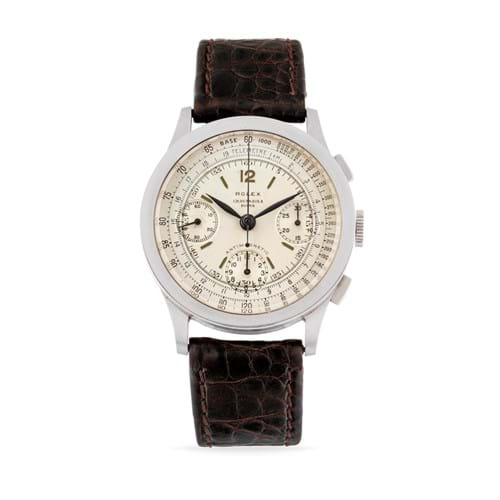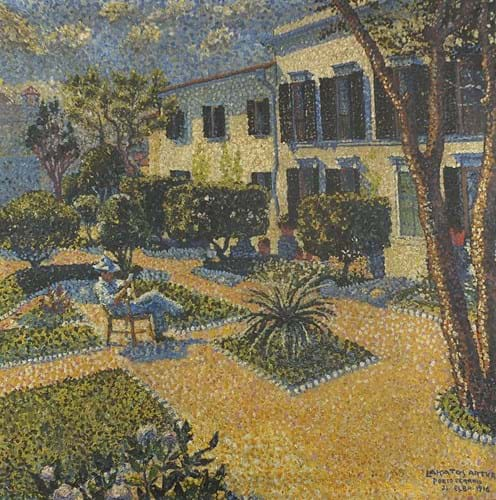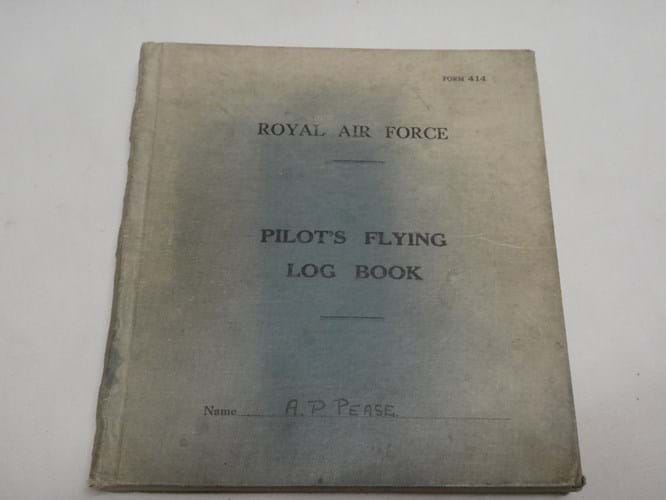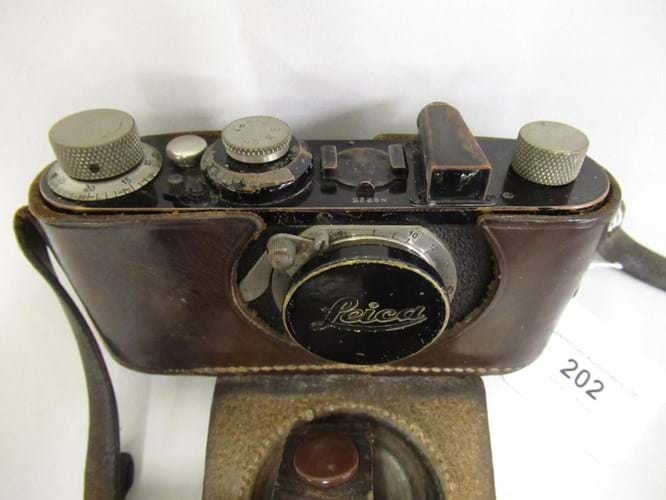
The reference 3330 antimagnetic is one of the rarest pre-Oyster chronographs made by Rolex. Produced in the late 1930s and early 1940s, it features a large 37mm case with a 12-hour register – both popular today but uncommon features at the time. This example, retailed by Italian jeweller Cravanzola, is in virtually unworn condition. It was consigned for sale at Finarte in Rome on June 13 by the daughter of the original owner. He had purchased the watch c.1940 shortly before he was killed during the Second World War. Estimated at €20,000-40,000, it did rather better selling at €180,000 (£153,000).
1. Rolex watch – €180,000 (£153,000)
The reference 3330 antimagnetic is one of the rarest pre-Oyster chronographs made by Rolex. Produced in the late 1930s and early 1940s, it features a large 37mm case with a 12-hour register – both popular today but uncommon features at the time. This example, retailed by Italian jeweller Cravanzola, is in virtually unworn condition. It was consigned for sale at Finarte in Rome on June 13 by the daughter of the original owner. He had purchased the watch c.1940 shortly before he was killed during the Second World War. Estimated at €20,000-40,000, it did rather better selling at €180,000 (£153,000).
Only a dozen of these have appeared for sale in the past decade. Another ‘near mint’ 3330 dated 1939 was sold by Phillips in 2016 for a premium-inclusive SFr390,000 (£310,000). Although it had a salmon pink dial without the retailer’s name, it had a serial number that was only nine digits apart from Finarte’s watch.
2. Pointillist landscape – £16,600
Although he trained in Munich and first worked in Paris where his works were hung at the Salon d'Automne, Artur Lakatos (1880-1968) returned to his native Hungary in the early 20th century Teaching at the School of Industrial Design in Budapest, he also worked as a designer of furniture, textiles and interiors. Many of his pictures reflect the influence of post impressionism such as this Tuscan pointillist oil on canvas, signed and inscribed 1916 - Portoferraio, Elba offered for sale at Eastbourne Auctions on June 8-10. Measuring 2ft 8in (79cm) square, it is of similar size and date to a pointillist landscape sold by Budapest auction house Kieselbach Gallery in 2008 for Ft8m (£23,400), the auction record for the artist according to ArtPrice.
Estimated at just £100-200, it found plenty of admirers before selling at £16,600 to a Hungarian buyer bidding via thesaleroom.com
3. Logbook from Flying Officer Arthur Peter Pease – £12,000
The highlight of the sale at Truro Auction Centre in Redruth, Cornwall on June 9 was an RAF logbook from Battle of Britain spitfire pilot Flying Officer Arthur Peter Pease (1913-40).
Born into a titled family, son of Sir Richard and Lady Pease, he was educated at Eton and Trinity College, Cambridge where he joined the University Air Squadron. The earliest entry in his logbook is for October 22, 1937.
David John Colin Pinckney (1920-42) was a school friend and they had befriended Richard Hope Hillary (1919-43) – who later immortalised Pease in his book The Last Enemy – during initial training. The three men had joined 603 (City of Edinburgh) Squadron and became its top fighter pilots.
Extracts-in the logbook include various attacks on German aircraft, forced landings and ultimately a record of Pease’s death on September 9. 1940. Shot down, his spitfire crashed at Kingswood, near Chartway Street, Kent.
Pease’s logbook, sold together with a selection of copy photographs, extracts from Cambridge University Air Squadron and a selection of copy research, was estimated at £500-700 but sold at £12,000.
4. Leica I camera – £36,500
The Leica I debuted at the 1925 Leipzig Spring Fair at a time when it was still common for glass plates to be used in cameras. The brainchild of Leitz director of research Oskar Barnack (1879-1936), he had begun work on adapting 35mm cinematic film for a still camera a decade earlier. The first prototypes issued in the early 1920s are the most expensive of all vintage cameras but any early Leica I is a trophy collectable. The example pictured here, offered by Lawrences of Bletchingley on June 7, crucially carries the serial number 225 that dates it to the second batch of production towards the end of 1925.
Offered together with numerous online photos showing its honest and seemingly working condition and the survival of its original brown leather case, it was guided at a modest £500-700, but raced away to bring £36,500.
5. Sailing presentation trophies – £1700
Sworders’ Fine Interiors sale included items from Bixley Manor, near Norwich - home to one of East Anglia’s best-known families. Ninety lots from the estate of businessman Sir Timothy James Alan Colman (1929-2021) and his wife Lady Mary Colman (née Bowes-Lyon), niece of the Queen Mother, were offered on June 14.
The great-grandson of Jeremiah James Colman (1830-98), the man who turned Colman’s Mustard into an international brand, Sir Timothy began his career on the shop floor of the Carrow Works in Norwich. However, in 1957 he became a director of Eastern Counties Newspapers – a company his ancestor Jeremiah Colman (1777-1851) had co-founded in 1844 – and was chairman of the group from 1969-96.
A skilled yachtsman, he claimed the record for the world's fastest yacht on several occasions (in 1980 his catamaran Crossbow II sailed at 36 knots). This maritime prowess was reflected in two sailing presentation trophies marked for Theodore Ross of Market Place, Norwich and hallmarked for London 1930. One is modelled as The Bell Buoy, Great Yarmouth and engraved with a line from the Kipling poem The Bell Buoy - 'I dip and I surge and I swing In the rip of the racing tide’ – with the other cast as a pennant buoy. Offered together, they made £1700.









